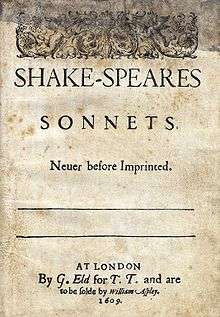Sonnet 77
| Sonnet 77 | |||||||
|---|---|---|---|---|---|---|---|
 The first two lines of Sonnet 77 in the 1609 Quarto | |||||||
|
| |||||||
| |||||||
Shakespeare's 77th sonnet repeats the theme of the passing of time and the inevitability of decay. There is less emphasis on the recuperative power of art than in some other works.
Paraphrase
When you look in your mirror, you will see how quickly you are aging. This blank book will allow you to record the impressions of your mind, and these impressions will themselves teach you. The lines in your face that your mirror shows you will remind you of the open mouths of fresh graves. The hands of the dial will truly teach you how time keeps pushing you towards death. Write these things down now, and when you return to them much later you will find that they have matured along with you; they will mean more to you then. The oftener you do this, the more "your book" will profit by the discipline.
Structure
Sonnet 77 is an English or Shakespearean sonnet. The English sonnet has three quatrains, followed by a final rhyming couplet. It follows the typical rhyme scheme of the form, abab cdcd efef gg and is composed in iambic pentameter, a type of poetic metre based on five pairs of metrically weak/strong syllabic positions. The 2nd line exemplifies a regular iambic pentameter:
× /× / × / × / × / Thy dial how thy precious minutes waste; (77.2)
- / = ictus, a metrically strong syllabic position. × = nonictus.
"Dial" is here 2 syllables, as it is in line 7.
Source and analysis
Since George Steevens and Edmond Malone, the poem has been taken as referring to the gift of a blank-book or book of tablets, perhaps to the beloved, although some have suggested a more distant friendship than that in the other sonnets. Edward Dowden hypothesized that the poem relates specifically to the Rival Poet: knowing that he has lost favor, Shakespeare makes a present of this blank book to the beloved, who will now have to fill it himself, since Shakespeare has fallen silent.
The mirror and dial referred to in the sonnet are often assumed to be devices represented on the cover of the book; alternately, as Rolfe hypothesized, they might have been gifts enclosed with the book. Henry Charles Beeching discounts any clear biographical clue in the poem, arguing that it is so unrelated to those next it in the sequence that it must be read apart.
Booth notes that the gift of a mirror and dial places the poem in the memento mori tradition; however, his sense of a pun on "wear" and "were" is regarded as forced by G. B. Evans.
Sonnet 77 is the midpoint in the sequence of 154 sonnets. The fact that it is about a mirror may be relevant to its placing. Edmund Spenser mentions mirrors at the midpoint of his sequence, Amoretti, Sonnet 45 of 89: "Leaue lady in your glasse of christall clene, / Your goodly selfe for euermore to vew".[2]
The original quarto's "blacks" in line 10 is almost universally emended to "blanks", following Alexander Dyce. Some critics have defended "blacks" as referring to printer's type, or to slate notebooks.
References
- ↑ Pooler, C[harles] Knox, ed. (1918). The Works of Shakespeare: Sonnets. The Arden Shakespeare [1st series]. London: Methuen & Company. OCLC 4770201.
- ↑ Larsen, Kenneth J. "Structure" in Essays on Shakespeare's Sonnets.
Further reading
- First edition and facsimile
- Shakespeare, William (1609). Shake-speares Sonnets: Never Before Imprinted. London: Thomas Thorpe.
- Lee, Sidney, ed. (1905). Shakespeares Sonnets: Being a reproduction in facsimile of the first edition. Oxford: Clarendon Press. OCLC 458829162.
- Variorum editions
- Alden, Raymond Macdonald, ed. (1916). The Sonnets of Shakespeare. Boston: Houghton Mifflin Company. OCLC 234756.
- Rollins, Hyder Edward, ed. (1944). A New Variorum Edition of Shakespeare: The Sonnets [2 Volumes]. Philadelphia: J. B. Lippincott & Co. OCLC 6028485.
- Modern critical editions
- Atkins, Carl D., ed. (2007). Shakespeare's Sonnets: With Three Hundred Years of Commentary. Madison: Fairleigh Dickinson University Press. ISBN 978-0-8386-4163-7. OCLC 86090499.
- Booth, Stephen, ed. (2000) [1st ed. 1977]. Shakespeare's Sonnets (Rev. ed.). New Haven: Yale Nota Bene. ISBN 0-300-01959-9. OCLC 2968040.
- Burrow, Colin, ed. (2002). The Complete Sonnets and Poems. The Oxford Shakespeare. Oxford: Oxford University Press. ISBN 978-0192819338. OCLC 48532938.
- Duncan-Jones, Katherine, ed. (2010) [1st ed. 1997]. Shakespeare's Sonnets. The Arden Shakespeare, Third Series (Rev. ed.). London: Bloomsbury. ISBN 978-1-4080-1797-5. OCLC 755065951.
- Evans, G. Blakemore, ed. (1996). The Sonnets. The New Cambridge Shakespeare. Cambridge: Cambridge University Press. ISBN 978-0521294034. OCLC 32272082.
- Kerrigan, John, ed. (1995) [1st ed. 1986]. The Sonnets ; and, A Lover's Complaint. New Penguin Shakespeare (Rev. ed.). Penguin Books. ISBN 0-14-070732-8. OCLC 15018446.
- Mowat, Barbara A.; Werstine, Paul, eds. (2006). Shakespeare's Sonnets & Poems. Folger Shakespeare Library. New York: Washington Square Press. ISBN 978-0743273282. OCLC 64594469.
- Orgel, Stephen, ed. (2001). The Sonnets. The Pelican Shakespeare (Rev. ed.). New York: Penguin Books. ISBN 978-0140714531. OCLC 46683809.
- Vendler, Helen, ed. (1997). The Art of Shakespeare's Sonnets. Cambridge, MA: The Belknap Press of Harvard University Press. ISBN 0-674-63712-7. OCLC 36806589.
.png)
